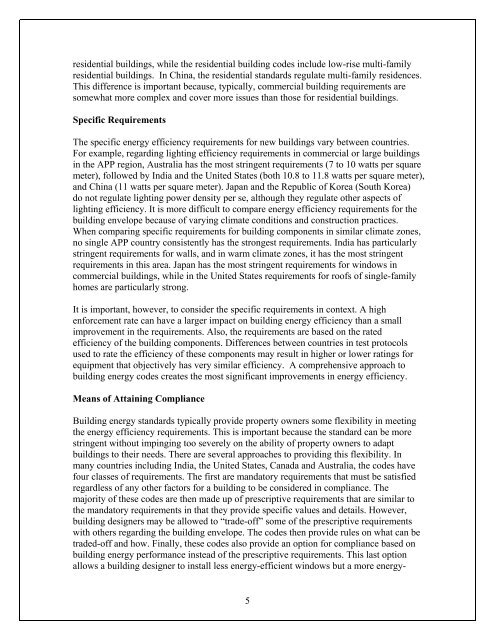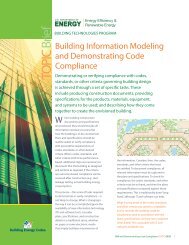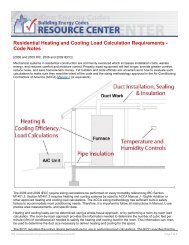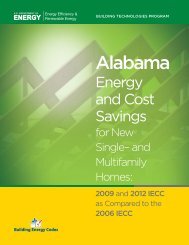Shaping the Energy Efficiency in New Buildings - Building Energy ...
Shaping the Energy Efficiency in New Buildings - Building Energy ...
Shaping the Energy Efficiency in New Buildings - Building Energy ...
Create successful ePaper yourself
Turn your PDF publications into a flip-book with our unique Google optimized e-Paper software.
esidential build<strong>in</strong>gs, while <strong>the</strong> residential build<strong>in</strong>g codes <strong>in</strong>clude low-rise multi-familyresidential build<strong>in</strong>gs. In Ch<strong>in</strong>a, <strong>the</strong> residential standards regulate multi-family residences.This difference is important because, typically, commercial build<strong>in</strong>g requirements aresomewhat more complex and cover more issues than those for residential build<strong>in</strong>gs.Specific RequirementsThe specific energy efficiency requirements for new build<strong>in</strong>gs vary between countries.For example, regard<strong>in</strong>g light<strong>in</strong>g efficiency requirements <strong>in</strong> commercial or large build<strong>in</strong>gs<strong>in</strong> <strong>the</strong> APP region, Australia has <strong>the</strong> most str<strong>in</strong>gent requirements (7 to 10 watts per squaremeter), followed by India and <strong>the</strong> United States (both 10.8 to 11.8 watts per square meter),and Ch<strong>in</strong>a (11 watts per square meter). Japan and <strong>the</strong> Republic of Korea (South Korea)do not regulate light<strong>in</strong>g power density per se, although <strong>the</strong>y regulate o<strong>the</strong>r aspects oflight<strong>in</strong>g efficiency. It is more difficult to compare energy efficiency requirements for <strong>the</strong>build<strong>in</strong>g envelope because of vary<strong>in</strong>g climate conditions and construction practices.When compar<strong>in</strong>g specific requirements for build<strong>in</strong>g components <strong>in</strong> similar climate zones,no s<strong>in</strong>gle APP country consistently has <strong>the</strong> strongest requirements. India has particularlystr<strong>in</strong>gent requirements for walls, and <strong>in</strong> warm climate zones, it has <strong>the</strong> most str<strong>in</strong>gentrequirements <strong>in</strong> this area. Japan has <strong>the</strong> most str<strong>in</strong>gent requirements for w<strong>in</strong>dows <strong>in</strong>commercial build<strong>in</strong>gs, while <strong>in</strong> <strong>the</strong> United States requirements for roofs of s<strong>in</strong>gle-familyhomes are particularly strong.It is important, however, to consider <strong>the</strong> specific requirements <strong>in</strong> context. A highenforcement rate can have a larger impact on build<strong>in</strong>g energy efficiency than a smallimprovement <strong>in</strong> <strong>the</strong> requirements. Also, <strong>the</strong> requirements are based on <strong>the</strong> ratedefficiency of <strong>the</strong> build<strong>in</strong>g components. Differences between countries <strong>in</strong> test protocolsused to rate <strong>the</strong> efficiency of <strong>the</strong>se components may result <strong>in</strong> higher or lower rat<strong>in</strong>gs forequipment that objectively has very similar efficiency. A comprehensive approach tobuild<strong>in</strong>g energy codes creates <strong>the</strong> most significant improvements <strong>in</strong> energy efficiency.Means of Atta<strong>in</strong><strong>in</strong>g ComplianceBuild<strong>in</strong>g energy standards typically provide property owners some flexibility <strong>in</strong> meet<strong>in</strong>g<strong>the</strong> energy efficiency requirements. This is important because <strong>the</strong> standard can be morestr<strong>in</strong>gent without imp<strong>in</strong>g<strong>in</strong>g too severely on <strong>the</strong> ability of property owners to adaptbuild<strong>in</strong>gs to <strong>the</strong>ir needs. There are several approaches to provid<strong>in</strong>g this flexibility. Inmany countries <strong>in</strong>clud<strong>in</strong>g India, <strong>the</strong> United States, Canada and Australia, <strong>the</strong> codes havefour classes of requirements. The first are mandatory requirements that must be satisfiedregardless of any o<strong>the</strong>r factors for a build<strong>in</strong>g to be considered <strong>in</strong> compliance. Themajority of <strong>the</strong>se codes are <strong>the</strong>n made up of prescriptive requirements that are similar to<strong>the</strong> mandatory requirements <strong>in</strong> that <strong>the</strong>y provide specific values and details. However,build<strong>in</strong>g designers may be allowed to “trade-off” some of <strong>the</strong> prescriptive requirementswith o<strong>the</strong>rs regard<strong>in</strong>g <strong>the</strong> build<strong>in</strong>g envelope. The codes <strong>the</strong>n provide rules on what can betraded-off and how. F<strong>in</strong>ally, <strong>the</strong>se codes also provide an option for compliance based onbuild<strong>in</strong>g energy performance <strong>in</strong>stead of <strong>the</strong> prescriptive requirements. This last optionallows a build<strong>in</strong>g designer to <strong>in</strong>stall less energy-efficient w<strong>in</strong>dows but a more energy-5
















